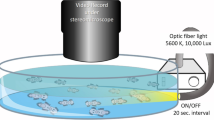Abstract
The swimming behaviour of many cercarial species is governed by sensitive responses to light and dark stimuli. We studied the effect of irradiance changes on swimming behaviour of Schistosoma mansoni cercariae and found only insignificant responses. Decreasing light intensity results in a weak tendency of the cercariae to start swimming movements, and increasing light intensity tends to inhibit the start of swimming. These responses seem not suitable to increase the transmission success. Whether the cercariae show chemo-orientation towards human skin was studied by video-tracking their swimming movements around agar containing human-skin-surface extracts and when immersed into skin extracts. They showed no directed chemotactic orientation, as they did not correct their swimming paths in direction towards the skin-extract substrates, also not when shifting between forward and backward swimming. However, the cercariae shifted more between backward and forward swimming and therewith increased their rate of change of direction. This response may support an accumulation around the skin substrates and could guide the cercariae towards the host’s skin surface when they are already in close proximity to it.

Similar content being viewed by others
References
Combes C, Fournier A, Moné H, Théron A (1994) Behaviours in trematode cercariae that enhance parasite transmission: patterns and processes. Parasitology 109(Suppl):S3–S13
Feiler W, Haas W (1988) Host-finding in Trichobilharzia ocellata cercariae: swimming and attachment to the host. Parasitology 96:493–505
Graefe G, Hohorst W, Dräger H (1967) Forked tail of the cercaria of Schistosoma mansoni—a rowing device. Nature 215:207–208
Haas W (1969) Reizphysiologische Untersuchungen an Cercarien von Diplostomum spathaceum. Zeitschr vergl Physiol 64:254–287
Haas W (1976) Die Anheftung (Fixation) der Cercarie von Schistosoma mansoni. Einfluss natürlicher Substrate und der Temperatur. Zeitschr Parasitenkd 49:63–72
Haas W (1992) Physiological analysis of cercarial behavior. J Parasitol 78:243–255
Haas W (1994) Physiological analyses of host-finding behaviour in trematode cercariae: adaptations for transmission success. Parasitology 109(Suppl):S15–S29
Haas W (2003) Parasitic worms: strategies of host finding, recognition and invasion. Zoology 106:349–364
Haas W, Haberl B (1997) Host recognition by trematode miracidia and cercariae. In: Fried B, Graczyk TK (eds) Advances in trematode biology. CRC, Boca Raton, pp 197–227
Haas W, Granzer M, Garcia EG (1987) Host identification by Schistosoma japonicum cercariae. J Parasitol 73:568–577
Haas W, Granzer M, Brockelman C (1990) Finding and recognition of the bovine host by the cercariae of Schistosoma spindale. Parasitol Res 76:343–350
Haas W, Haberl B, Schmalfuss G, Khayyal MT (1994) Schistosoma haematobium cercarial host-finding and host-recognition differs from that of S. mansoni. J Parasitol 80:345–353
Haas W, Körner M, Hutterer E, Wegner M, Haberl B (1995) Finding and recognition of the snail intermediate hosts by 3 species of echinostome cercariae. Parasitology 110:133–142
Haas W, Grabe K, Geis C, Päch T, Stoll K, Fuchs M, Haberl B, Loy C (2002) Recognition and invasion of human skin by Schistosoma mansoni cercariae: the key role of l-arginine. Parasitology 124:153–167
Haberl B, Körner M, Spengler Y, Hertel J, Kalbe M, Haas W (2000) Host-finding in Echinostoma caproni: Miracidia and cercariae use different signals to identify the same snail species. Parasitology 120:479–486
Haeberlein S, Haas W (2008) Chemical attractants of human skin for swimming Schistosoma mansoni cercariae. Parasitol Res (in press)
Körner M, Haas W (1998) Chemo-orientation of echinostome cercariae towards their snail hosts: amino acids signal a low host-specificity. Int J Parasitol 28:511–516
Saladin KS (1982) Schistosoma mansoni: cercarial responses to irradiance changes. J Parasitol 68:120–124
Shiff CJ, Graczyk TK (1994) A chemokinetic response in Schistosoma mansoni cercariae. J Parasitol 80:879–883
Stirewalt MA (1971) Penetration stimuli for schistosome cercariae. In: Cheng TC (ed) Aspects of the biology of symbiosis. Univ Park Press, Baltimore, pp 1–23
Acknowledgements
This work was supported by the Deutsche Forschungsgemeinschaft. We thank Simone Haeberlein for advice. The experiments performed in this work comply with the current laws of Germany.
Author information
Authors and Affiliations
Corresponding author
Rights and permissions
About this article
Cite this article
Brachs, S., Haas, W. Swimming behaviour of Schistosoma mansoni cercariae: responses to irradiance changes and skin attractants. Parasitol Res 102, 685–690 (2008). https://doi.org/10.1007/s00436-007-0812-4
Received:
Accepted:
Published:
Issue Date:
DOI: https://doi.org/10.1007/s00436-007-0812-4




